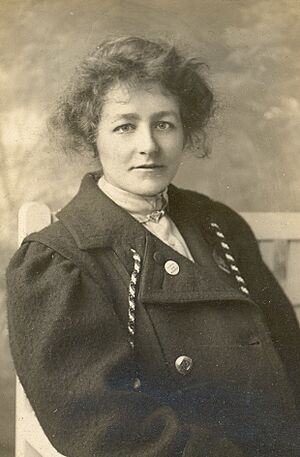Edith New facts for kids
Quick facts for kids
Edith New
|
|
|---|---|

by Peter Nairn of Hawick
|
|
| Born |
Edith Bessie New
17 March 1877 Swindon, England
|
| Died | 2 January 1951 (age 73) Liskeard, England
|
| Known for | First suffragette vandal |
Edith Bessie New (born March 17, 1877 – died January 2, 1951) was an English suffragette. Suffragettes were women who fought for the right to vote. Edith New was one of the first suffragettes to use strong protest actions, like breaking windows, to get attention. She and Mary Leigh were surprised when their actions were celebrated. People cheered for them when they were released from prison in 1908.
Contents
Edith New's Early Life
Edith Bessie New was born in Swindon, England. She was one of five children. Her mother, Isabella, was a music teacher. Her father, Frederick James New, worked for the railway. Sadly, her father died when Edith was less than a year old. He was hit by a train. By the age of 14, Edith was already working as a teacher. In 1901, she moved to East London.
Fighting for Women's Votes
In the early 1900s, Edith New stopped teaching. She started working for the Women's Social and Political Union (WSPU). This group worked hard to get women the right to vote. Edith traveled all over England. She spoke to many groups about the women's movement.
In January 1908, Edith New and Olivia Smith chained themselves to the railings of 10 Downing Street. This is where the Prime Minister of the UK lives. They shouted "Votes for Women!" This protest helped other suffragettes, Flora Drummond and Mary Macarthur, try to sneak in. They were all arrested.
Breaking Windows for Change
In June 1908, during another protest, Edith New and Mary Leigh broke two windows at 10 Downing Street. They were arrested again. They were sent to Holloway prison for two months. This was one of the first times suffragettes used property damage as a protest method.
At first, Edith and Mary worried that other suffragettes might not like what they did. But Emmeline Pankhurst, a main leader of the suffrage movement, visited them in prison. She told them she approved of their actions. She believed these strong protests helped their cause. More protest actions were planned soon after. When they were in court, the women even said they might use bombs next time.
When they were released from prison in August 1908, a big parade was held for them. Many suffragettes, including Christabel Pankhurst, celebrated their release.
Honored for Her Bravery
The WSPU gave Edith New a special Hunger Strike Medal. It was given 'for Valour' (bravery). This was to thank her for her important work. While she was in prison, Edith went on a hunger strike. This meant she refused to eat. It was a protest to demand the right for women to vote.
In 1909, Edith New was seen in Hawick, Scotland. She was speaking to crowds outside the Tower Hotel. In 1911, Edith New left the WSPU. She moved to Lewisham and went back to teaching.
Edith New's Later Life and Legacy
Edith New later moved to a small town called Polperro in Cornwall. She passed away in early 1951. She was 73 years old.
In 2011, a street in Swindon was named after her. This was to honor her memory. On March 19, 2016, a special blue plaque was placed on her birthplace. It is at 24 North Street, Swindon. This plaque helps people remember her important contributions.
Images for kids




